Your Guide to Beautiful Ribbons for Wedding Decor
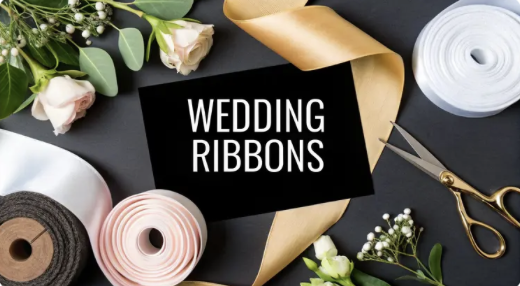
Ribbons at a wedding are so much more than just a decorative trim. Think of them as a powerful, and wonderfully affordable, way to weave your unique style and colour palette throughout your entire celebration. From luxurious silk streamers cascading from a bridal bouquet to charming rustic ties on wedding favours, they add a personal, symbolic touch that pulls your whole aesthetic together.
Why Ribbons Are a Wedding Day Essential
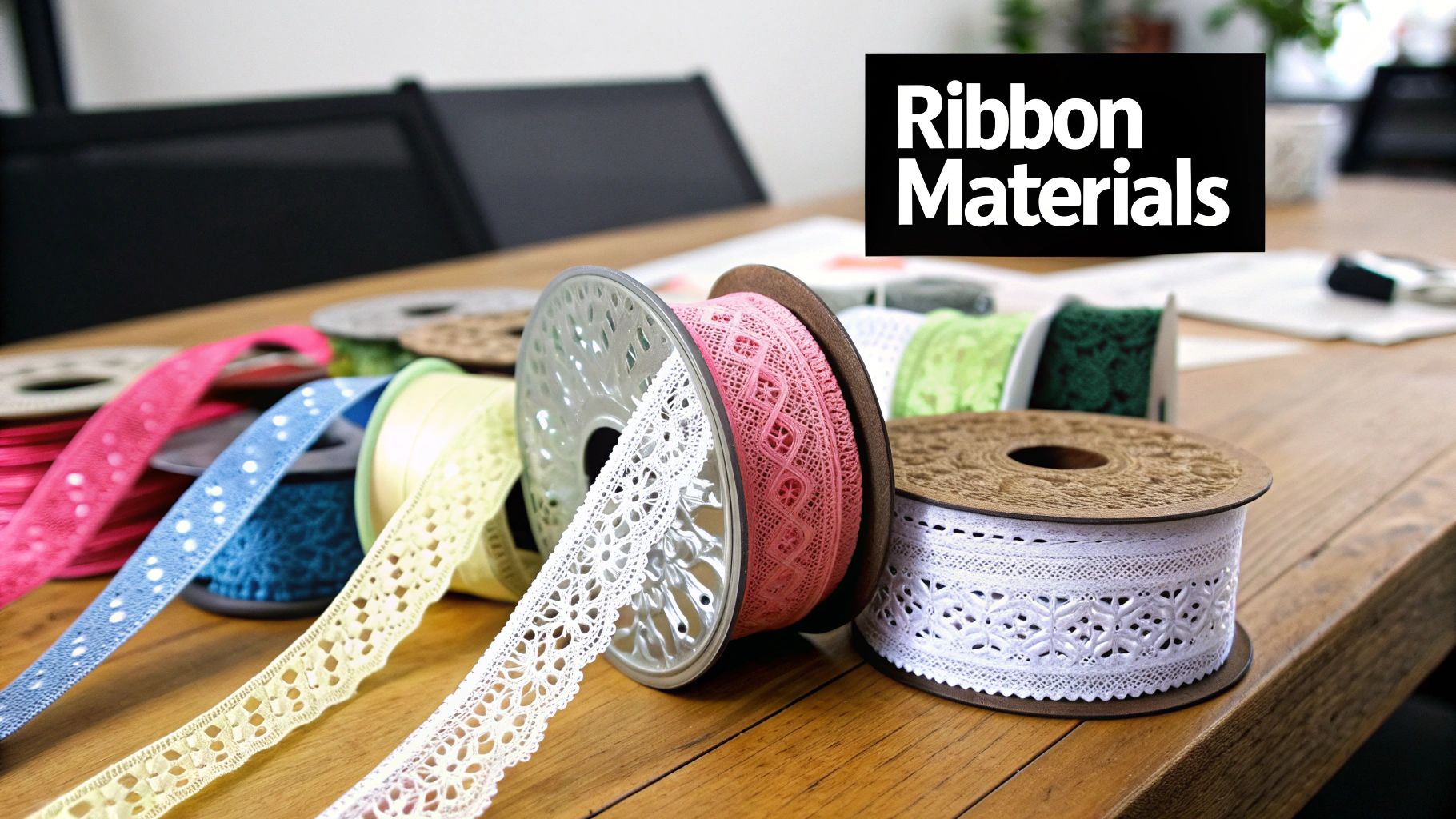
Imagine ribbons as the common thread connecting every little detail of your special day. They're a simple yet incredibly effective way to tell your visual story, turning ordinary items into memorable, personalised elements. Just one spool can transform your invitations, chairs, floral arrangements, and even the wedding cake into a cohesive and beautiful display.
For many couples, ribbons are also steeped in meaning. Historically, they represent unity and celebration—after all, the phrase "tying the knot" has literal roots in ancient ceremonies where a couple's hands were bound together with ribbon. This tradition adds a lovely layer of sentiment to their use today.
A Timeless Tradition in UK Weddings
In the UK, the role of ribbons in weddings is both significant and deeply ingrained. In fact, you'd be hard-pressed to find certain key elements, like bouquets and stationery, without them. A recent survey of wedding suppliers really brings this home, revealing that approximately 65% of wedding bouquets in the region feature ribbons tied around the stems.
When it comes to materials, satin is the undisputed champion, used in about 80% of these cases for its classic, luxurious feel. It’s a small detail that shows how a simple ribbon can elevate an arrangement from merely beautiful to truly special. You can dive deeper into UK wedding statistics and trends over at Party Houses.
The true magic of using ribbons for a wedding lies in their versatility. They can be grand and dramatic or subtle and delicate, adapting perfectly to any theme, from a formal black-tie affair to a relaxed bohemian gathering.
Weaving Your Personal Story
Ultimately, the real power of wedding ribbons is their ability to express your personality. They offer a fantastic opportunity to inject colour, texture, and emotion into your decor, making the day feel completely yours.
- Create a Consistent Colour Palette: Using the same ribbon colour across different elements is a surefire way to create a harmonious, polished look.
- Add Meaningful Detail: Perhaps you could choose a specific material or colour that holds personal significance for you as a couple.
- Enhance Your Theme: A rustic hessian ribbon is a perfect match for a barn wedding, while a rich velvet adds a touch of opulence to a winter ceremony.
By treating ribbons as a foundational design element rather than just an afterthought, you can unlock their full potential to make your wedding day feel complete and uniquely you.
Choosing The Perfect Ribbon Material
Picking the right material is your first real decision when it comes to choosing beautiful ribbons for your wedding. The fabric you go for does so much more than just add a pop of colour; it completely dictates the ribbon's texture, how it drapes, and whether it will hold a crisp, sharp bow.
Think of it like choosing fabric for a dress. A floaty, ethereal organza won't give you the same structured bow as a sturdy grosgrain. In the same way, a rustic hessian ribbon brings a completely different feeling to the table than a sleek, glossy satin. Getting to grips with these differences is the secret to matching the ribbon to your overall wedding aesthetic and its specific job on the day.
The Classic Choices: Satin and Silk
Satin is probably the most popular wedding ribbon, and it's easy to see why. Its signature glossy finish on one side and matte finish on the other creates a classic, formal look that suits almost any theme. It’s also affordable, comes in a rainbow of colours, and holds a bow shape brilliantly. This makes it a go-to for chair sashes, car decorations, and wrapping up little favour boxes.
Silk, on the other hand, is the absolute pinnacle of luxury. It's incredibly soft, with a gentle, romantic drape and a subtle lustre that catches the light in the most beautiful way. While it's certainly a more premium choice, nothing quite compares to its fluid, elegant movement. It's the perfect material for those long, trailing bouquet tails that billow gracefully in the breeze.
Exploring Texture and Sheen
Beyond the classics of satin and silk, there's a whole world of texture waiting to be discovered. Each material can bring a unique dimension to your wedding décor, helping you tell a more detailed visual story.
- Organza: A sheer, lightweight fabric that has a delicate, airy feel. It’s wonderful for creating soft, dreamy layers, tying around napkins, or adding a translucent touch to your invitations.
- Velvet: Rich, plush, and wonderfully opulent. Velvet ribbon adds instant warmth and a sense of vintage luxury, making it a stunning choice for autumn or winter weddings.
- Grosgrain: Known for its distinct ribbed texture, grosgrain is strong and durable. It’s fantastic for creating structured, neat bows and works really well as a modern accent on stationery.
- Hessian (Burlap): For a rustic, country, or barn-themed wedding, hessian is the obvious choice. Its coarse, natural texture adds an earthy, charming touch to jam jar arrangements, table runners, and outdoor decorations.
The image below shows just how powerful harmonising ribbon textures and colours can be, turning simple place settings into a cohesive, thoughtful design.
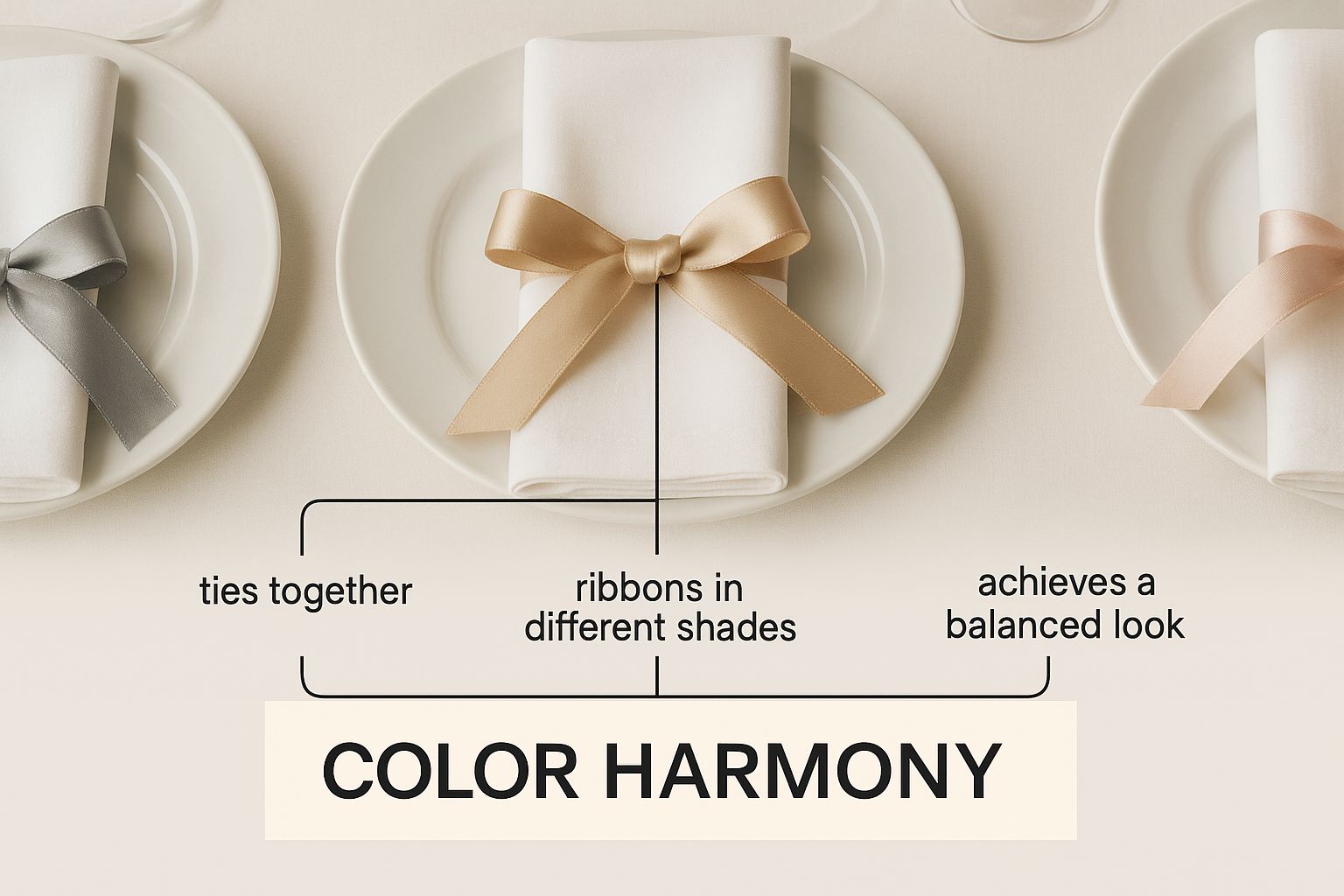
It really demonstrates that even subtle variations in shade and material can create a rich, layered look that feels intentional and professionally styled.
To help you decide, we've put together a quick comparison of the most popular wedding ribbon materials.
Wedding Ribbon Material Comparison
| Material | Look & Feel | Best For | Theme Suitability |
|---|---|---|---|
| Satin | Glossy on one side, matte on the other; classic | Chair sashes, car bows, favour boxes, structured bows | Classic, Formal, Glamorous |
| Silk | Incredibly soft, subtle lustre, beautiful drape | Bouquet tails, high-end invitations, dress details | Romantic, Luxury, Fine Art, Bohemian |
| Organza | Sheer, lightweight, airy, and delicate | Layering on chairs, napkin ties, translucent stationery wraps | Dreamy, Ethereal, Romantic |
| Velvet | Plush, soft, rich, and opulent | Bouquet wraps, invitations, place settings, winter/autumn accents | Vintage, Luxe, Moody, Autumn/Winter |
| Grosgrain | Ribbed texture, sturdy, and structured | Gift wrapping, modern stationery, structured bows, cake decorations | Modern, Preppy, Nautical |
| Hessian/Burlap | Coarse, natural, earthy, and textured | Jam jar arrangements, table runners, outdoor décor, favour tags | Rustic, Country, Barn, Woodland |
This table gives a great overview, but remember to think about the ribbon's job on the day.
Consider the function just as much as the look. Will the ribbon be tied into a sharp bow or left to hang loosely? A stiffer material like grosgrain or double-faced satin is best for structured shapes, while soft silk or chiffon is made for elegant, flowing tails.
Ultimately, finding the perfect ribbons comes down to the mood you want to create. By understanding what makes each material special, you can choose fabrics that not only look beautiful but also perfectly complement your theme, your budget, and every last detail of your big day.
Using Colour to Tell Your Wedding Story

Colour isn’t just something you see; it’s something you feel. When it comes to your wedding, the ribbons you choose are a powerful way to set the entire mood for the day, speaking an emotional language all their own. Think of your ribbon palette as the visual soundtrack to your wedding, guiding how your guests feel from the moment they arrive.
A deep, passionate red can whisper of romance and drama, while soft, cool blues create a sense of serenity and calm. Bright, sunny yellows spark instant joy, and earthy greens connect your celebration to nature and new beginnings. Every single hue carries its own unique energy, giving you the tools to craft an atmosphere that feels truly personal.
This is your chance to look beyond fleeting trends and pick shades that genuinely reflect you as a couple. Your chosen colours can tell the story of your journey, your personalities, and your hopes for the future, all woven into the very fabric of your day.
Creating a Cohesive Colour Palette
The secret to a stunning, polished look is cohesion. You want your ribbons for wedding décor to feel like they belong together, not like a chaotic jumble. I always advise starting with a core palette of two or three colours. This could be inspired by anything—the season, your venue, or even your favourite flowers.
Once you have those core colours locked in, you can start layering in accent shades. For instance, if your main colours are a classic navy blue and blush pink, a little pop of gold ribbon can add an instant touch of luxury. Or, if you’re planning a rustic wedding with lots of neutral tones, a bold burnt orange ribbon can bring in a gorgeous burst of warmth and energy.
The most memorable palettes often blend harmonious shades with one surprising accent. That unexpected touch of colour creates real visual interest and makes your design feel intentional and completely unique.
Personalisation is a massive part of UK weddings right now, and that’s had a huge impact on ribbon choices. We've seen the demand for colourful wedding flowers with equally vibrant ribbons just skyrocket—supplier requests have shot up by over 200% since 2023. This reflects a wider movement where 27% of couples are now commissioning custom-coloured ribbons just to get their floral designs perfect. You can read more on the latest trends in this brilliant report from Hitched.
Practical Strategies for Colour Matching
Matching ribbons is definitely an art, but it doesn’t need to be stressful. The main goal is to create a sense of harmony that ties every little detail together seamlessly.
Here are a few practical ways to do it:
- Match the Bridesmaid Dresses: This is a classic for a reason. Using a key colour from the bridesmaid dresses for your bouquet ribbons, chair sashes, and stationery creates a beautifully unified look.
- Complement Your Flowers: Instead of a perfect match, try choosing ribbon colours that complement your blooms. A dusty blue ribbon, for example, looks absolutely stunning against a bouquet of soft white and peach roses.
- Introduce a Bold Contrast: If your overall theme is quite soft and neutral, use your ribbons to make a real statement. A rich emerald green or a deep burgundy can provide a dramatic and elegant contrast that really makes people notice.
Don't be afraid to play around with different combinations. To make things a bit easier, you can explore a full spectrum of hues when you shop by colour for your wedding ribbons, helping you find the perfect shade for every single element of your celebration.
Inspiring Ways to Use Ribbons on Your Wedding Day
Right, let’s get creative. While a classic ribbon-wrapped bouquet is a truly beautiful touch, the potential for using ribbons for wedding décor goes so much further. This incredibly versatile element can pop up in countless surprising and delightful ways, adding layers of texture, colour, and personality to every part of your celebration.
From grand, sweeping statements to the tiniest personal details, ribbons are a fantastic tool for expressing your unique style. They can turn a simple space into something magical or elevate an everyday object into a memorable keepsake. Let's look at some inspiring ideas that move far beyond the expected.
Elevate Your Ceremony and Reception Décor
Think of your ceremony and reception spaces as blank canvases just waiting for you. Ribbons are the perfect medium to add strokes of beauty and colour, helping to define spaces, guide your guests, and create a wonderfully festive atmosphere from the moment they arrive.
For a stunning ceremony backdrop, picture long, cascading lengths of ribbon hanging in your chosen colours. It's a simple idea that creates incredible movement and makes for a perfect photo opportunity. You could also tie ribbons to the chairs lining the aisle, crafting a beautiful and welcoming pathway for your entrance.
When it comes to the reception, here are a few ideas to get you started:
- Chair Sashes: A classic for a reason. Tying a wide satin or organza ribbon into a lush bow on the back of each chair instantly elevates the entire look of your dining space.
- Table Runners: For a more modern or rustic feel, try laying overlapping ribbons of different widths and textures down the centre of your tables instead of a traditional fabric runner.
- Hanging Installations: For a real showstopper, suspend a hoop or even a branch from the ceiling and drape it with ribbons and fairy lights. It creates an enchanting centrepiece above the dance floor or top table.
Add a Special Touch to Accessories and Stationery
It’s often the small, thoughtful details that guests remember most. Ribbons are perfect for weaving a consistent, beautiful touch through your stationery and personal accessories, creating a cohesive theme that starts long before the big day itself.
A simple ribbon belly band tied around your invitation suite gives guests a little preview of your colour palette. You can then carry this through to the day-of stationery, perhaps by tying a small, delicate ribbon to the top of each menu card or order of service.
Key Insight: Using the same type and colour of ribbon on your invitations, place cards, and favours creates a powerful sense of visual continuity. This small detail makes your entire wedding feel incredibly polished and well-planned.
Another delightful idea is to create ribbon wands for your guests to wave as you make your grand exit from the ceremony. It’s a fun and wonderfully photogenic alternative to confetti, and the wands themselves become lovely keepsakes for your friends and family to take home.
From the Getaway Car to the Wedding Cake
Don’t forget about the grand finale and the sweet centrepiece of the reception! Ribbons are a traditional and utterly charming way to decorate your wedding transport. A large, beautifully tied bow on the front of the car adds a touch of classic romance and signals the celebratory send-off. There are even specialised ribbons designed for this purpose; you can learn more about finding the perfect wedding car satin ribbon to complete the look.
The wedding cake also offers a wonderful opportunity for a bit of ribbon detailing. A simple ribbon wrapped around the base of each tier can tie the cake's design into your overall colour scheme beautifully. For a more dramatic effect, a cascade of delicate, sugar-paste ribbons tumbling down the side of the cake can look absolutely breathtaking.
Ultimately, the ways you can use ribbons for your wedding are limited only by your imagination. Whether you opt for bold, dramatic installations or subtle, romantic accents, they are a wonderfully effective way to weave your personal story into the fabric of your big day.
Mastering the Hand-Tied Bouquet Ribbon
Adding that final ribbon flourish to a bouquet is one of the most satisfying DIY wedding jobs you can tackle. It’s the little detail that transforms a simple bunch of flowers into a true bridal accessory. With just a few simple techniques, you can get a professional-looking finish that perfectly complements your style.
This practical guide will walk you through the process in simple, easy-to-follow steps. We'll cover everything from getting the length right to securing the ribbon for a flawless, lasting finish. So, whether you're dreaming of a classic, neat bow or a romantic cascade of long, flowing tails, you can absolutely create it yourself.
Step 1: Getting the Measurement Right
First things first, you need to work out how much ribbon you'll need, and this depends entirely on the style you're going for. A common mistake is to underestimate the length, which can leave you with sad, skimpy tails or a tiny bow. It's always, always better to start with more ribbon than you think you need; you can easily trim the excess later.
For a classic wrap with medium-length tails (around 45-60 cm each), a good starting point is 2 to 3 metres of ribbon. If you're imagining those dramatic, floor-sweeping tails you see in fine art and bohemian weddings, you'll need a lot more—plan for at least 4 to 5 metres to get that breathtaking, flowing effect.
Step 2: Wrapping the Bouquet Stems
Once you've got your ribbon, it's time to wrap the stems. Start by making sure the floral tape holding your bouquet together is secure. Take one end of your ribbon and place it right at the top of the stems, just underneath the blooms, leaving a long tail hanging down for now.
Begin wrapping the ribbon tightly and neatly down the stems, overlapping each layer just slightly to make sure no floral tape peeks through. Keep going until you've covered the desired length of the stems, usually about 15-20 cm. This creates a comfortable and elegant 'handle' for holding the bouquet.
A great little florist's trick is to pop a pearl-headed pin through the ribbon and into the stems at the very top and bottom of your wrap. This gives it extra security and makes sure the ribbon won’t slip or unravel during the day.
Step 3: Tying the Perfect Finish
With the stems all wrapped up, you can create the final look. How you tie the ribbon is what really defines the bouquet's style. Here are two of the most popular options:
-
The Classic Knot and Tails: This is the simplest and most common method. Just take the two ends of your ribbon—the initial tail you left hanging and the end of your wrapping ribbon—and tie them into a simple, tight double knot. Let the tails hang down naturally. For a clean look, snip the ends at a sharp angle or into a 'V' shape.
-
The Simple Bow: For a more traditional finish, tie the two ends into a lovely bow after making your initial knot. Fiddle with the loops until they are even and look well-proportioned to the size of your bouquet. This works especially well with stiffer ribbons like double-faced satin or grosgrain, which hold their shape beautifully.
By following these simple steps, you can confidently add a personal, hand-tied ribbon to your bridal or bridesmaid bouquets. It’s a memorable detail that brings a huge amount of charm and personality to your big day.
Your Wedding Ribbon Questions Answered
As you get closer to the big day, it's completely normal for a few practical questions about ribbons to pop up. You start wondering about how much to buy, what sizes work best, and whether you can mix and match different styles. Getting these little details sorted is what makes every part of your wedding feel polished and perfectly planned.
Think of this as your go-to guide for those last-minute queries. We’ve pulled together the most common questions we hear from couples and laid out clear, simple answers to help you feel confident in your choices.
How Much Ribbon Do I Need for My Wedding?
This is the big one, and honestly, the answer comes down to how you’re planning to use it. There’s no magic number, but you can easily work out what you’ll need with a bit of prep.
First, jot down a list of every single place you want to feature a ribbon. Next, grab a tape measure and get a sample measurement for one of each item to create a baseline.
- Bridal Bouquet: For a really lush look with beautiful, long tails, you’ll want around 2 to 3 metres of ribbon. If you're dreaming of dramatic, floor-sweeping tails, you might even need up to 5 metres.
- Chair Sashes: A good, safe estimate is about 2 metres per chair. This gives you plenty of length to tie a full, beautiful bow without a struggle.
- Wedding Favours: This really depends on the size of your favours, but 30 to 50 cm per item is usually more than enough for a simple knot or a tiny, neat bow.
Once you've got your total, always, always buy at least 15-20% extra ribbon. This little buffer is an absolute lifesaver. It’ll cover any mis-ties, practice bows, and those brilliant last-minute creative ideas that are bound to happen.
What Is the Best Ribbon Width for Wedding Invitations?
When it comes to wedding stationery, it’s all about the delicate details. You need a ribbon that adds a hint of elegance without overpowering the design or making your invitations too chunky to pop in the post.
As a general rule, a narrower ribbon is your best bet. I'd recommend looking for widths between 7mm and 15mm. This size is just right for creating a sophisticated belly band to hold your invitation suite together, or for tying a graceful little bow on the corner. Satin or silk ribbons are perfect here, as they lie nice and flat and give a premium feel.
Can I Mix Different Types of Ribbons Together?
Oh, absolutely! In fact, mixing different ribbon materials is one of my favourite ways to create a high-end, textured look that brings so much depth to your décor. It’s a technique that works wonders on bouquets and ceremony backdrops.
A classic combination is pairing a wide, simple satin ribbon with something narrower and more luxurious, like a velvet or a floaty, hand-dyed silk. The contrast in textures is just stunning and feels incredibly thoughtful and custom.
The secret to getting this right is keeping your colour palette cohesive. Stick to shades that complement each other and try not to go overboard—two or three different textures is usually the sweet spot. This ensures the final look is chic and stylish, not cluttered. It’s a brilliant way to elevate your whole wedding design.
At Ribbons4u Ltd, we have a huge selection of beautiful ribbons to help you bring your wedding vision to life, from classic satin to luxurious velvet and rustic hessian. Explore our complete collection and find the perfect finishing touches for your special day.




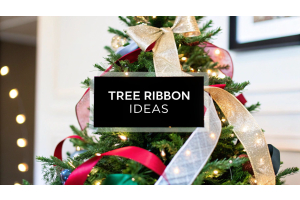
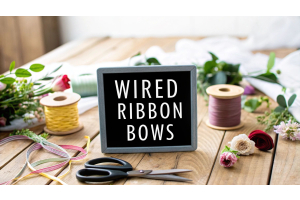


 Facebook
Facebook Twitter
Twitter Pinterest
Pinterest